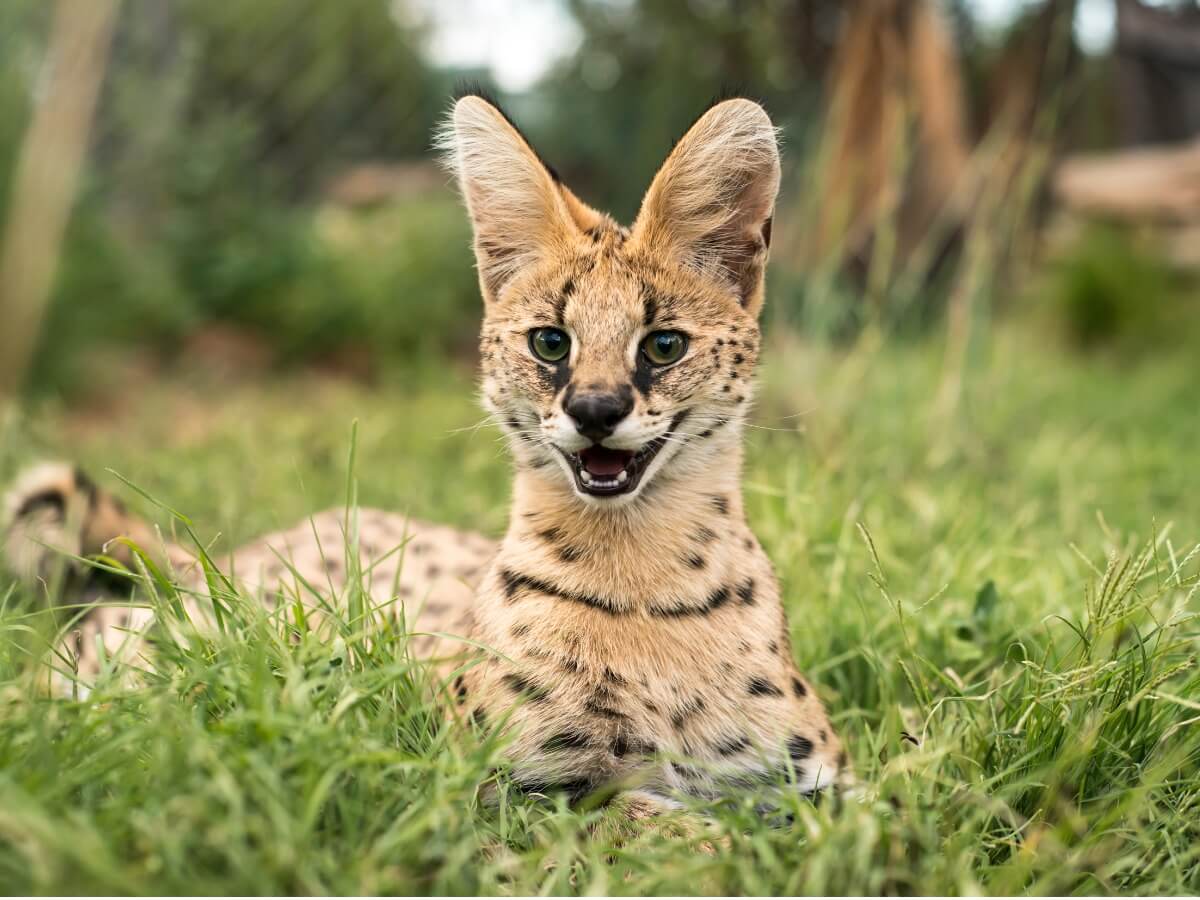Is it Possible to Keep a Serval as a Pet?

For lovers of wild felines and exotic animals, keeping a serval as a pet may seem like an easy way to keep one at home without the dangers posed by larger species such as tigers or leopards. However, this is a misconception, as they’re still wild animals.
In this article, we’ll explore the different aspects of keeping these animals in captivity, from the legal formalities, to the care they need. Don’t miss out on anything, as it’s a very controversial topic that involves several important aspects of animal welfare and nature conservation.
What’s a serval?
The first thing we need to do is to know this animal and its nature. The serval (Leptailurus serval) is a medium-sized feline (9 to 18 kilograms – 20 to 40 pounds – with the males being larger than the females). They have a slender build and a small head in relation to its body. Its long legs make it a great climber and swimmer, in addition to being a very agile runner.
This species is abundant in the scrublands of savannahs, jungles, and the semi-desert areas of central and southern Africa. In these lands, it feeds on small animals and, occasionally, on small antelopes. It’s a nocturnal animal, very intelligent, and a great hunter.
It currently has a conservation status of Least Concern (LC). Even though its populations maintain stable numbers, it faces numerous threats from humans: illegal hunting to trade its skin and the reduction of terrain and resources due to the extension of livestock farming are some examples.

Is it legal to keep a serval as a pet?
The answer to this question varies depending on the region where you are. In a country such as Spain, for example, it’s illegal to keep one of these felines at home, so anyone trying to would face big fines or even imprisonment.
In other places, such as Canada, keeping them as pets is also prohibited, but special permits are given for other purposes, such as breeding, entertainment, or export. Further south, in the United States, several states restrict their ownership while others are more permissive with the acquisition and keeping of servals.
Therefore, someone considering keeping a serval as a pet should be aware of the specific laws in their region and abide by them.
However, even if it were legal to keep this species in your region, the real difficulty lies in its maintenance. In the following section, we’ll explain more.
Does a serval live well in a house?
To say that it’s difficult to keep a serval in a house is an understatement. Many people see this feline as a large version of the domestic cat, but nothing could be further from the truth. Servals are very strong, have a great hunting instinct, and are territorial. In other words, they would still be wild beings enclosed within four walls, even if they were tamed.
Servals hunt birds on the fly and are able to stun a fish with one swipe without it leaving the water.
This feline would be a danger in the home, both for material goods and for humans and other animals that live with them. It’s almost impossible to train them, as they respond aggressively when limits are set. In addition, they’ll leave urine and scratches all over the house.
In addition to this, recreating the diet they follow in the wild may seem simple, as they’re strict carnivores, but nutritional deficiencies are frequent. Not being able to satisfy their hunting instinct will lead servals to develop behavioral problems, including aggression.
Hybrid pets
Since living with a serval has ended in disaster in most cases, some people opt for declawing, that is, the surgical removal of the feline’s claws. This option is considered animal abuse and has been banned in many countries.
Another emerging trend in feral cat ownership is the hybridization of feral cats with domestic cats. In this case, at the end of the 1990s, a new breed was created and popularized: the savannah cat. This isn’t without its moral problems, as the savannah is still a feline with a wild appearance, albeit with a more submissive temperament.
Generally, people who get one have to pay large sums of money to later see it die from the effects of captivity or abandon it because of the impossibility of handling it and the danger it creates.

In short, the desire to have a wild animal in your home may come from a fascination for wildlife, but there are much better ways to get closer to it than having a serval as a pet. Remember that the buying and selling of wild animals always involves some form of mistreatment, from illegal breeding to removal from the wild. Acquiring one is the opposite of loving nature.
If you aren’t a fan of domestic cats, there are several associations devoted to the rescue of exotic animals. Many of them are in urgent need of foster homes, so don’t hesitate to volunteer for this. Your home can be populated by unusual animals, and you’ll be doing it legally and for the good of the animal.
For lovers of wild felines and exotic animals, keeping a serval as a pet may seem like an easy way to keep one at home without the dangers posed by larger species such as tigers or leopards. However, this is a misconception, as they’re still wild animals.
In this article, we’ll explore the different aspects of keeping these animals in captivity, from the legal formalities, to the care they need. Don’t miss out on anything, as it’s a very controversial topic that involves several important aspects of animal welfare and nature conservation.
What’s a serval?
The first thing we need to do is to know this animal and its nature. The serval (Leptailurus serval) is a medium-sized feline (9 to 18 kilograms – 20 to 40 pounds – with the males being larger than the females). They have a slender build and a small head in relation to its body. Its long legs make it a great climber and swimmer, in addition to being a very agile runner.
This species is abundant in the scrublands of savannahs, jungles, and the semi-desert areas of central and southern Africa. In these lands, it feeds on small animals and, occasionally, on small antelopes. It’s a nocturnal animal, very intelligent, and a great hunter.
It currently has a conservation status of Least Concern (LC). Even though its populations maintain stable numbers, it faces numerous threats from humans: illegal hunting to trade its skin and the reduction of terrain and resources due to the extension of livestock farming are some examples.

Is it legal to keep a serval as a pet?
The answer to this question varies depending on the region where you are. In a country such as Spain, for example, it’s illegal to keep one of these felines at home, so anyone trying to would face big fines or even imprisonment.
In other places, such as Canada, keeping them as pets is also prohibited, but special permits are given for other purposes, such as breeding, entertainment, or export. Further south, in the United States, several states restrict their ownership while others are more permissive with the acquisition and keeping of servals.
Therefore, someone considering keeping a serval as a pet should be aware of the specific laws in their region and abide by them.
However, even if it were legal to keep this species in your region, the real difficulty lies in its maintenance. In the following section, we’ll explain more.
Does a serval live well in a house?
To say that it’s difficult to keep a serval in a house is an understatement. Many people see this feline as a large version of the domestic cat, but nothing could be further from the truth. Servals are very strong, have a great hunting instinct, and are territorial. In other words, they would still be wild beings enclosed within four walls, even if they were tamed.
Servals hunt birds on the fly and are able to stun a fish with one swipe without it leaving the water.
This feline would be a danger in the home, both for material goods and for humans and other animals that live with them. It’s almost impossible to train them, as they respond aggressively when limits are set. In addition, they’ll leave urine and scratches all over the house.
In addition to this, recreating the diet they follow in the wild may seem simple, as they’re strict carnivores, but nutritional deficiencies are frequent. Not being able to satisfy their hunting instinct will lead servals to develop behavioral problems, including aggression.
Hybrid pets
Since living with a serval has ended in disaster in most cases, some people opt for declawing, that is, the surgical removal of the feline’s claws. This option is considered animal abuse and has been banned in many countries.
Another emerging trend in feral cat ownership is the hybridization of feral cats with domestic cats. In this case, at the end of the 1990s, a new breed was created and popularized: the savannah cat. This isn’t without its moral problems, as the savannah is still a feline with a wild appearance, albeit with a more submissive temperament.
Generally, people who get one have to pay large sums of money to later see it die from the effects of captivity or abandon it because of the impossibility of handling it and the danger it creates.

In short, the desire to have a wild animal in your home may come from a fascination for wildlife, but there are much better ways to get closer to it than having a serval as a pet. Remember that the buying and selling of wild animals always involves some form of mistreatment, from illegal breeding to removal from the wild. Acquiring one is the opposite of loving nature.
If you aren’t a fan of domestic cats, there are several associations devoted to the rescue of exotic animals. Many of them are in urgent need of foster homes, so don’t hesitate to volunteer for this. Your home can be populated by unusual animals, and you’ll be doing it legally and for the good of the animal.
All cited sources were thoroughly reviewed by our team to ensure their quality, reliability, currency, and validity. The bibliography of this article was considered reliable and of academic or scientific accuracy.
- Thiel, C. 2019. Leptailurus serval (amended version of 2015 assessment). The IUCN Red List of Threatened Species 2019: e.T11638A156536762. https://dx.doi.org/10.2305/IUCN.UK.2019-3.RLTS.T11638A156536762.en. Accessed on 27 January 2022.
- Leptailurus serval (serval). (s. f.). Animal Diversity Web. Recuperado 27 de enero de 2022, de https://animaldiversity.org/accounts/Leptailurus_serval/
- Ministry of Forests, Lands, Natural Resource Operations and Rural Development. (2019, 15 abril). Controlled Alien Species – Province of British Columbia. Government of British Columbia. Recuperado 27 de enero de 2022, de https://www2.gov.bc.ca/gov/content/environment/plants-animals-ecosystems/cas
This text is provided for informational purposes only and does not replace consultation with a professional. If in doubt, consult your specialist.








